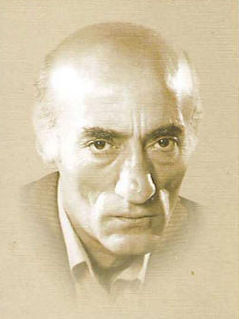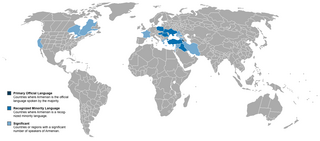
Mithra is the Zoroastrian angelic Divinity (yazata) of Covenant, Light, and Oath. In addition to being the divinity of contracts, Mithra is also a judicial figure, an all-seeing protector of Truth, and the guardian of cattle, the harvest, and of the Waters.

Argishti I, was the sixth known king of Urartu, reigning from 786 BC to 764 BC. He founded the citadel of Erebuni in 782 BC, which is the present capital of Armenia, Yerevan. Alternate transliterations of the name include Argishtis, Argisti, Argišti, and Argishtish.
Armenian mythology originated in ancient Indo-European and Urartian traditions, gradually incorporating Mesopotamian, Iranian, and Greek ideas and deities. There are signs that the ancient Armenians were initially nature worshipers and in time came to worship national gods, many adopted from neighboring cultures.

Karen Demirchyan was a Soviet and Armenian politician. He served as the First Secretary of the Armenian Soviet Socialist Republic from 1974 to 1988. Soon after his reemergence into active politics in independent Armenia in the late 1990s, he became President of the National Assembly in 1999 until his assassination with other politicians in parliament in the Armenian parliament shooting.

As polytheistic systems evolve, there is a tendency for one deity, usually male, to achieve preeminence as king of the gods. This tendency can parallel the growth of hierarchical systems of political power in which a monarch eventually comes to assume ultimate authority for human affairs. Other gods come to serve in a Divine Council or pantheon - such subsidiary courtier-deities are usually linked by family ties from the union of a single husband or wife, or else from an androgynous divinity who is responsible for the creation.

Yerablur is a military cemetery located on a hilltop in the outskirts of Yerevan, Armenia. Since 1988, Yerablur has become the burial place of Armenian soldiers who lost their lives during the Nagorno-Karabakh war.
In the earliest prehistoric period Astghik, or Astɫik, had been worshipped as the Armenian deity of fertility and love, later the skylight had been considered her personification, and she had been the consort of Vahagn. In the later heathen period she became the goddess of love, maidenly beauty, and water sources and springs. Her worship was derived from the two Indian princes who took refuge in the region of Armenia.

Tatul ; known as Pirmalak or Firmalak until 1935 and Areg until 2006, is a village in the Aragatsotn Province of Armenia. The village was renamed after the Nagorno-Karabakh War commander and the National Hero of Armenia Tatul Krpeyan, who was born in the village.

Tatul Krpeyan was an Armenian commander. He was the self-appointed leader of paramilitary units in Getashen and Martunashen villages in Shahumyan Region of Soviet Azerbaijan during the Nagorno-Karabakh War. He was killed during Operation Ring by the Soviet Azerbaijani OMON.
Areg or AREG may refer to:

The Armenian Pantheon of Tbilisi, also known as Khojivank or Khojavank, is an Armenian architectural complex in north-eastern part of Avlabari district of Tbilisi, Georgia. Many notable Armenian writers, artists and public figures are buried there.

Saint John the Baptist Church is an active church in the old area of Kond, Yerevan, Armenia. First, it was built on the height of Kond district, in 1710, in the place of a medieval church ruined as the result of a destructive earthquake. It was built by a rich man, Melik Aghamal, living in Yerevan. Like the other medieval churches, this is a three-nave basilic church. The rectangular plan of the church includes the prayer-hall and the main altar on the eastern side, attached to which are the sacristies.

Rafael Israelyan was an Armenian architect and designer. He is the author of an architectural heritage of civil buildings, monuments and design works.

Komitas Park and Pantheon is located in Yerevan's Shengavit District, on the right side of the main Arshakunyats Avenue, in Armenia. It was formed in 1936 after the demolition of the "Mler" cemetery and its historic chapel.

Hrant Matevosyan was an Armenian writer and script writer. By the time of his death he was considered Armenia's "most prominent and accomplished contemporary novelist".

Vardan Stepanyan, better known as Dushman Vardan, was an Armenian military commander during the Nagorno-Karabakh War. He is considered a hero in Armenia.
Robert Elibekyan is an Armenian painter.

Areg Elibekyan is an Armenian painter.

The Ministry of Energy Infrastructures and Natural Resources of the Republic of Armenia is the ministry responsible for the management of the energy systems, and control of the exploitation of natural resources in Armenia. It elaborates and implements the policies of the Republic of Armenia Government in the energy sector.

Artsakh Basketball Club, is a professional basketball team based in Stepanakert; the capital of the unrecognized Republic of Artsakh. They are the basketball section of Artsakh FC, an Armenian football club currently based in Yerevan. Artsakh BC was Founded in 2017, it currently plays in the Armenia Basketball League A.
















